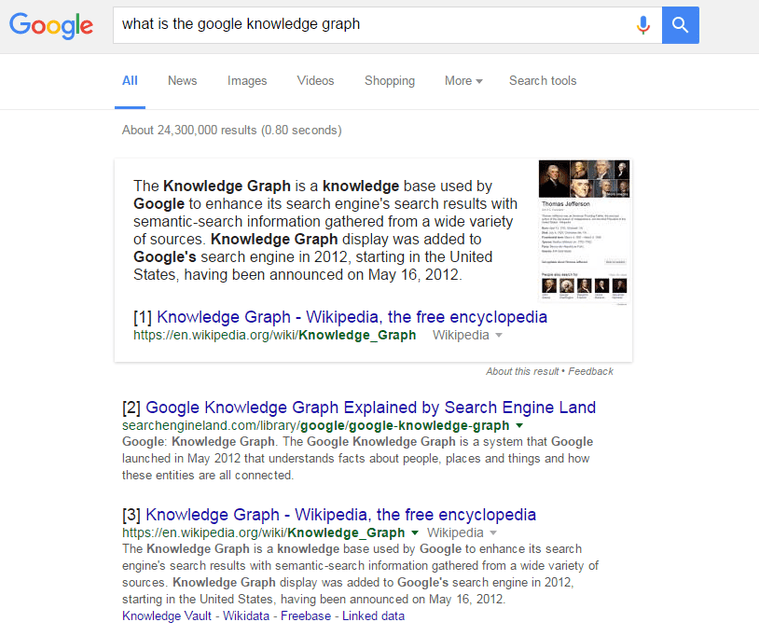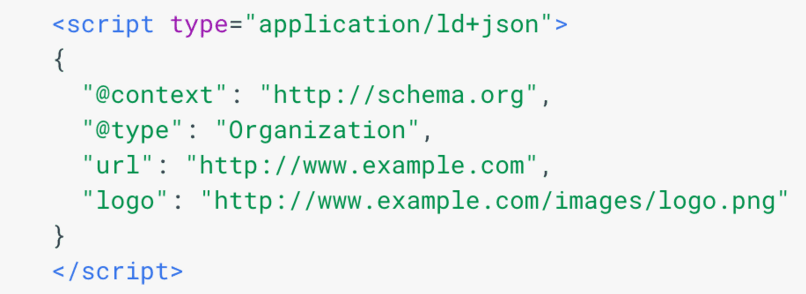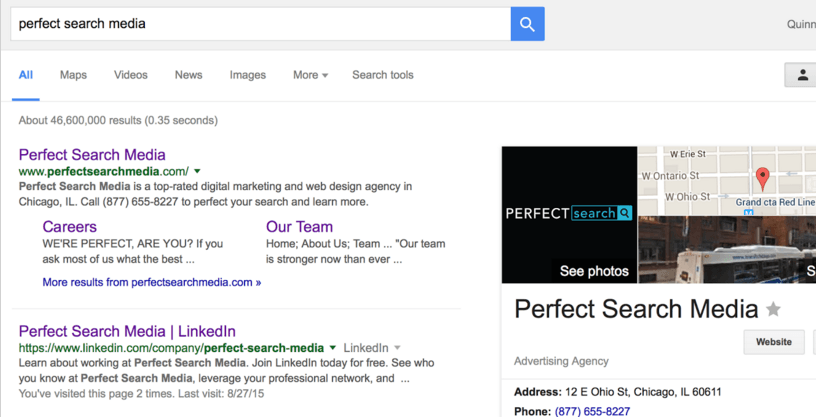A Cheat Sheet to Acing the Google Knowledge Graph

Like Chicago’s unpredictable weather, Google is constantly changing. Since its inception, Google’s search engine results page, or SERP, has undergone countless transformations (read up about the most recent SERP changes!), often causing anxiety for SEOs and digital marketers alike.
As Google evolves, so must our strategies. First introduced in 2012, Google’s Knowledge Graph has demonstrated the search engine’s ongoing shift towards a more contextual, semantic search interface. So how can a business take advantage of this newer SERP feature? Before we get to that, let’s tackle an easier question.
What’s a knowledge graph?
To best answer this, let’s do a quick Google search…
As you can see, Google seamlessly answers our question, pulling relevant information straight from Wikipedia. To put it simply, the Knowledge Graph aims to provide searchers with personalized, rather than computerized, answers.
According to Google, “the perfect search engine should understand exactly what you mean and give you back exactly what you want.” The Knowledge Graph attempts to do exactly this. Instead of only recognizing strings of words, the Knowledge Graph demonstrates Google’s ability to better understand what the user wants.
Why is it important to optimize for the Knowledge Graph?
Over the past several years, the evolution of Google’s SERP has diminished the emphasis on achieving top organic rankings. More recently, Google removed right-side ads and added a fourth top ad in “highly commercial” searches, pushing the first organic position even further down the SERP.
As Google’s evolution continues, taking advantage of above-the-fold real estate will become increasingly important and difficult. Showing in the Knowledge Graph doesn’t only increase exposure, it can also help brick-and-mortar stores gain more local business. On top of all this, a brand that shows in the Knowledge Graph looks both established and reputable.
Sounds great, right? So how can a business optimize for Google Knowledge Graph space? Just keep reading.
1) Take advantage of microdata with schema markup
Search engines are certainly impressive, but they aren’t actually very smart. Like I mentioned earlier, Google can easily recognize strings of words, but it doesn’t know what those words actually mean.
Enter schema markup. Using various HTML codes, schema helps search engines better understand what they’re looking at. Implementing these tags across your site can both improve organic visibility and influence Knowledge Graph answers.
For instance, the schema markup below tells Google that the example website represents an organization and also tells the search engine the location of its logo.
There are several other tags for reviews, local businesses, recipes, and more. For additional information, be sure to check out Google’s tips for customizing your Knowledge Graph.
If you’re looking to become a schema pro, read Benn’s blog post Schema 101: An Introduction to Microdata Markup.
2) Optimize your Google+ and Google My Business pages
If you have a local brick-and-mortar location, it’s critical that you claim and optimize your business’s Google+ and Google My Business accounts. Doing so is one of the easiest ways to show in the local Knowledge Graph. Make sure to fill out all of the pertinent information, such as business hours and call info. Acquiring reviews through these accounts can further improve your chances of showing in the Knowledge Graph.
It’s also worth mentioning that Google owns YouTube, so it can’t hurt to optimize any videos your business has published.
3) Add your business to Wikidata.org
Wikidata is a collaboratively edited data repository and knowledge base operated by Wikimedia Foundations. With several million data items, it’s no wonder why Google uses this source to fill its Knowledge Graph. Luckily, it’s not too hard to create an entry.
If you have some spare time, it might be worthwhile creating a Wikipedia page for your business, too. That being said, Wikipedia generally has much stricter guidelines to follow, making it a lot harder to actually get published on the “free encyclopedia.”
—
As Google evolves, so must our SEO strategies. Use the above tips to improve your business’s chances of showing in the Knowledge Graph and reap the benefits that this new way of search has to offer.
Do you have other strategies for showing in Google’s Knowledge Graph? Are you a schema markup master? Tweet us @Perfect_Search or email us at info@perfectsearchmedia.com.

Quinn, a Notre Dame alum, hails from Oconomowoc, Wisconsin (A.K.A. BROconomowoc, A.K.A. The Real OC). Though he’s not afraid to admit that he wants to swim in a pool of spaghetti noodles, his guilty pleasures are shower beers and The Bachelor.



